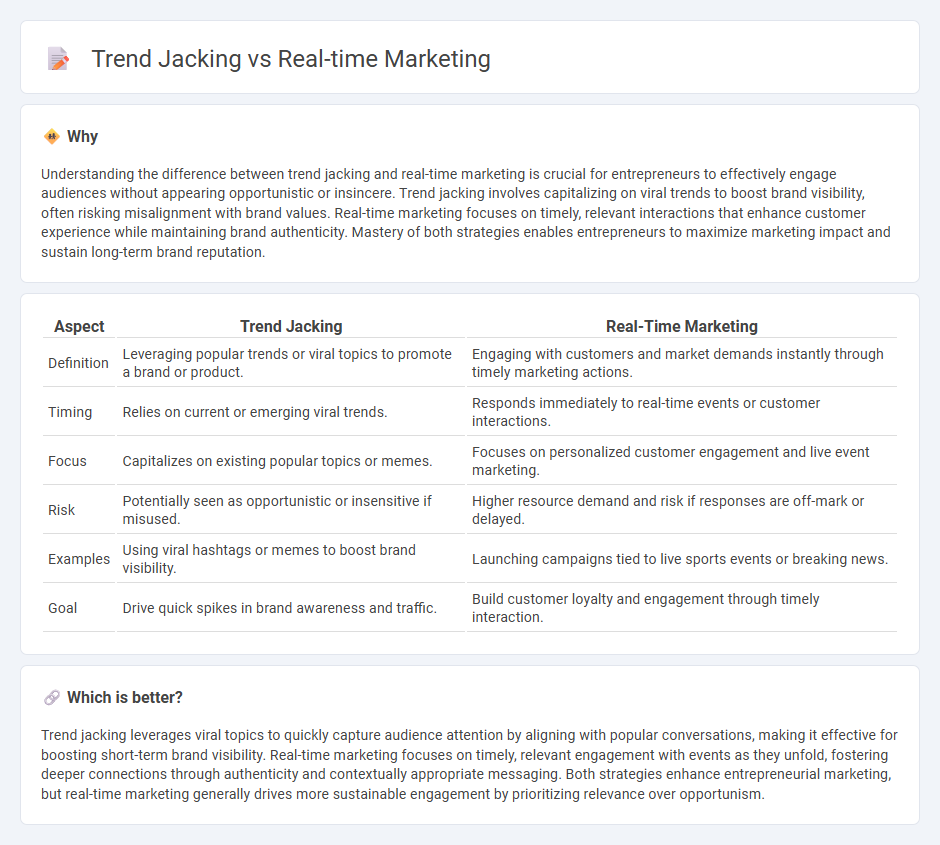
Trend jacking leverages popular culture moments to quickly align a brand with current conversations, capturing audience interest through timely relevance. Real-time marketing involves immediate, context-aware responses to live events, enhancing customer engagement by delivering personalized and relevant messaging. Discover how these dynamic strategies can elevate your entrepreneurial marketing efforts.
Why it is important
Understanding the difference between trend jacking and real-time marketing is crucial for entrepreneurs to effectively engage audiences without appearing opportunistic or insincere. Trend jacking involves capitalizing on viral trends to boost brand visibility, often risking misalignment with brand values. Real-time marketing focuses on timely, relevant interactions that enhance customer experience while maintaining brand authenticity. Mastery of both strategies enables entrepreneurs to maximize marketing impact and sustain long-term brand reputation.
Comparison Table
| Aspect | Trend Jacking | Real-Time Marketing |
|---|---|---|
| Definition | Leveraging popular trends or viral topics to promote a brand or product. | Engaging with customers and market demands instantly through timely marketing actions. |
| Timing | Relies on current or emerging viral trends. | Responds immediately to real-time events or customer interactions. |
| Focus | Capitalizes on existing popular topics or memes. | Focuses on personalized customer engagement and live event marketing. |
| Risk | Potentially seen as opportunistic or insensitive if misused. | Higher resource demand and risk if responses are off-mark or delayed. |
| Examples | Using viral hashtags or memes to boost brand visibility. | Launching campaigns tied to live sports events or breaking news. |
| Goal | Drive quick spikes in brand awareness and traffic. | Build customer loyalty and engagement through timely interaction. |
Which is better?
Trend jacking leverages viral topics to quickly capture audience attention by aligning with popular conversations, making it effective for boosting short-term brand visibility. Real-time marketing focuses on timely, relevant engagement with events as they unfold, fostering deeper connections through authenticity and contextually appropriate messaging. Both strategies enhance entrepreneurial marketing, but real-time marketing generally drives more sustainable engagement by prioritizing relevance over opportunism.
Connection
Trend jacking leverages current popular trends to create relevant marketing content, while real-time marketing focuses on immediate engagement with events as they unfold. Both strategies rely on rapid response and cultural awareness to capture audience attention and boost brand visibility. Their connection lies in utilizing timely opportunities to enhance entrepreneurial marketing impact effectively.
Key Terms
Agility
Real-time marketing capitalizes on current events as they happen, while trend jacking strategically leverages popular trends for brand promotion, both requiring high agility in execution. Agile marketing teams quickly adapt content and campaigns to resonate with dynamic audience interests and shifting market conditions. Discover more insights on enhancing marketing agility for better brand impact.
Timing
Real-time marketing emphasizes responding immediately to current events or consumer interactions to maximize engagement, while trend jacking involves leveraging popular trends or viral topics to gain visibility by associating a brand with existing buzz. Timing is crucial in both strategies, as real-time marketing demands rapid execution during live events, and trend jacking requires swift adaptation to fast-evolving internet trends before they become outdated. Explore strategies to master timing and optimize your marketing impact with real-time marketing and trend jacking.
Audience Engagement
Real-time marketing leverages live events or immediate circumstances to connect with the target audience, enhancing engagement through timely relevance and authenticity. Trend jacking involves capitalizing on popular trends or viral topics to capture audience attention quickly, though it risks appearing opportunistic if not aligned with brand identity. Explore detailed strategies and case studies to optimize audience engagement in both real-time marketing and trend jacking.
Source and External Links
How Leading Brands Leverage Real-Time Marketing Successfully - Real-time marketing involves reacting instantly to audience needs and trending events, deploying campaigns that capture attention by engaging in current conversations to boost brand awareness, SEO, and sales.
Real-Time Marketing Strategies (With Benefits) | Indeed.com - This marketing strategy focuses on connecting with target audiences during trends or events, improving engagement, keeping the brand relevant, creating urgency, and diversifying content types.
Real Time Marketing | Sprout Social - Real-time marketing requires planning around triggers, audiences, communication methods, and desired outcomes to deliver timely, relevant messages that enhance customer interaction and build brand credibility.
 dowidth.com
dowidth.com